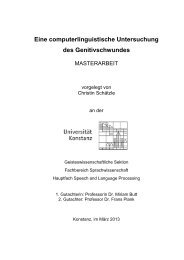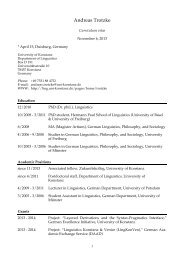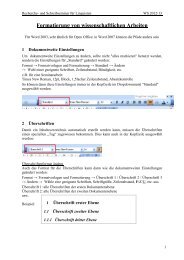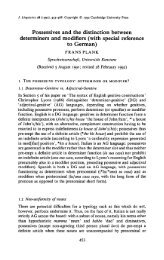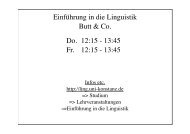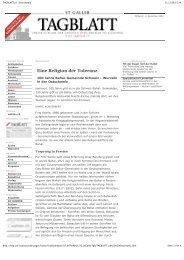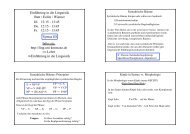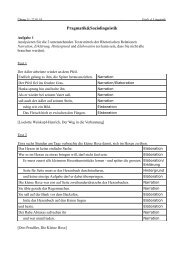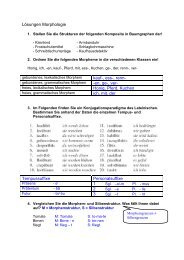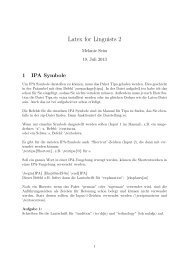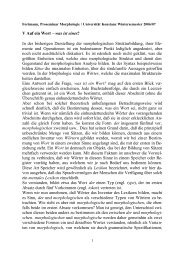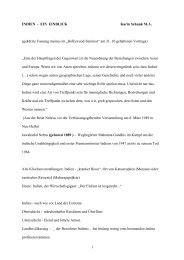6. Internal structure of complex words To recapitulate. For us ...
6. Internal structure of complex words To recapitulate. For us ...
6. Internal structure of complex words To recapitulate. For us ...
You also want an ePaper? Increase the reach of your titles
YUMPU automatically turns print PDFs into web optimized ePapers that Google loves.
Plank, Morphology 1: <strong>6.</strong> <strong>Internal</strong> <strong>structure</strong> <strong>of</strong> <strong>complex</strong> <strong>words</strong> 1<br />
<strong>6.</strong> <strong>Internal</strong> <strong>structure</strong> <strong>of</strong> <strong>complex</strong> <strong>words</strong><br />
<strong>To</strong> <strong>recapitulate</strong>. <strong>For</strong> <strong>us</strong>, morphological analysis, so far, consists in:<br />
• segmenting word-forms into morphs, = minimal differences <strong>of</strong> form<br />
that can be systematically matched to minimal differences <strong>of</strong><br />
meaning or grammar;<br />
• unifying (allo-)morphs as realisations <strong>of</strong> one and the same morpheme<br />
if, despite having distinct forms, they have the same meaning/grammar<br />
and are in complementary distribution (hence are unable to contrast);<br />
• dealing with relations <strong>of</strong> allomorphy depending on:<br />
• the kind <strong>of</strong> the alternation itself (phonological or not),<br />
• the kind <strong>of</strong> its conditioning (phonological, morphological,<br />
semantic, lexical);<br />
• thereby accounting for relationships <strong>of</strong> dependency: the selection<br />
among allomorphs depends on some other part <strong>of</strong> the same word;
Plank, Morphology 1: <strong>6.</strong> <strong>Internal</strong> <strong>structure</strong> <strong>of</strong> <strong>complex</strong> <strong>words</strong> 2<br />
• classifying <strong>of</strong> morphemes<br />
• by stat<strong>us</strong>:<br />
free, lexical or bound, grammatical<br />
= word, stem, root = affix or other exponent <strong>of</strong> terms<br />
<strong>of</strong> morphological categories or<br />
category bundles<br />
LEXEME GRAMMEME<br />
GRAMMEME (“function word”)<br />
• by meaning:<br />
persons, animates, things, actions, events,<br />
properties etc. (general criterion: time stability?);<br />
more concrete [= typically LEXEMES] vs. more abstract<br />
meanings (e.g. plural, future) [= typically GRAMMEMES]
Plank, Morphology 1: <strong>6.</strong> <strong>Internal</strong> <strong>structure</strong> <strong>of</strong> <strong>complex</strong> <strong>words</strong> 3<br />
• by position, especially in the case <strong>of</strong> affixes:<br />
• before, after, inside, around the stem<br />
(prefix, suffix, infix, circumfix, ambifix)<br />
• closer to or more distant from stem/edge <strong>of</strong> word-form<br />
cf. un-de-cipher-abil-ity, re-place-ment-s,<br />
anti-dis-establish-ment-ar-ian-ism<br />
(Is this only a question <strong>of</strong> order?)<br />
• anything else, necessitated by aspects <strong>of</strong> the <strong>structure</strong> <strong>of</strong> <strong>words</strong> that<br />
we have so far disregarded?<br />
This is the question we are looking into now.
Plank, Morphology 1: <strong>6.</strong> <strong>Internal</strong> <strong>structure</strong> <strong>of</strong> <strong>complex</strong> <strong>words</strong> 4<br />
Ai Weiwei, Template, installation at documenta 12, swept down by a thunderstorm<br />
http://www.flickr.com/photos/wolfgangstaudt/1402852146/in/set-72157602070098419/
Plank, Morphology 1: <strong>6.</strong> <strong>Internal</strong> <strong>structure</strong> <strong>of</strong> <strong>complex</strong> <strong>words</strong> 5<br />
<strong>6.</strong>1. Templatic (“flat”) word <strong>structure</strong><br />
If the correct answer is “no”: templatic (or “flat”) morphology<br />
That is, word <strong>structure</strong> consists in linear (= temporal) sequences <strong>of</strong><br />
immediate constituents (morphs), which at the same time are the<br />
ultimate word constituents;<br />
• these are ordered in terms <strong>of</strong> position classes relative to stem/root and<br />
the word edge,<br />
• with the ordering regulated by universal or language-particular rules,<br />
• and with the possibility <strong>of</strong> one-way or mutual dependencies among<br />
position classes (‘if position class n is occupied by x, position class m<br />
m<strong>us</strong>t be occupied by y’),<br />
This is all there is in the case <strong>of</strong> templatic word <strong>structure</strong>.
Plank, Morphology 1: <strong>6.</strong> <strong>Internal</strong> <strong>structure</strong> <strong>of</strong> <strong>complex</strong> <strong>words</strong> 6<br />
Word <strong>structure</strong>s are not always templatic, but templatic word <strong>structure</strong><br />
does exist, in many languages and for at least subparts <strong>of</strong> their<br />
morphological systems.<br />
It seems that inflectional morphology is especially prone to be templatic.<br />
(The distinction <strong>of</strong> INFLECTION and DERIVATION will occupy <strong>us</strong> later.)
Plank, Morphology 1: <strong>6.</strong> <strong>Internal</strong> <strong>structure</strong> <strong>of</strong> <strong>complex</strong> <strong>words</strong> 7<br />
The issue <strong>of</strong> ordering the parts <strong>of</strong> templatic word-wholes<br />
Ordering in terms <strong>of</strong> position classes can be (or seem) ad hoc/arbitrary,<br />
requiring stipulation for each particular case in each particular language<br />
(thereby complicating the task <strong>of</strong> the learner <strong>of</strong> that particular language);<br />
or it may follow more general morphological, syntactic, semantic, or<br />
phonological principles.<br />
Here are some such general principles that may play a role for the<br />
arrangement <strong>of</strong> the parts <strong>of</strong> templatically-organised <strong>words</strong>/word-forms:<br />
• Word HEADS may consistently, in all <strong>complex</strong> <strong>words</strong>/word-forms <strong>of</strong><br />
a language, come either before or after their DEPENDENTS.<br />
Hence no need to learn how to order each individual head and<br />
dependent. (More on heads and dependents presently.)
Plank, Morphology 1: <strong>6.</strong> <strong>Internal</strong> <strong>structure</strong> <strong>of</strong> <strong>complex</strong> <strong>words</strong> 8<br />
• The ordering <strong>of</strong> morphological markers may correspond, directly or<br />
in mirror-image order, to the levels <strong>of</strong> the syntactic constructions <strong>of</strong><br />
which the <strong>words</strong>/word-forms concerned are part <strong>of</strong>.<br />
Example from Old Georgian, a Kartvelian/South Caucasian language:<br />
ḳlite-n-i sasupevel-isa ca-ta-jsa-n-i<br />
key-PL-NOM kingdom-GEN heaven-PL.OBL-GEN-PL-NOM<br />
'(the) keys <strong>of</strong> the kingdom <strong>of</strong> (the) heavens'<br />
The final noun has no less than four suffixes:<br />
(i) in ca-ta-jsa-n-i the PLURAL.OBLIQUE suffix -ta comes<br />
first/innermost beca<strong>us</strong>e this suffix identifies the number<br />
reference ('more than one') as well as (cumulatively) the<br />
syntactic function <strong>of</strong> this noun phrase itself within its<br />
construction, that <strong>of</strong> attribute (in the plural there is no separate<br />
genitive for attributes, but a general oblique case for all nonsubject<br />
functions);
Plank, Morphology 1: <strong>6.</strong> <strong>Internal</strong> <strong>structure</strong> <strong>of</strong> <strong>complex</strong> <strong>words</strong> 9<br />
(ii) next comes the GENITIVE suffix -jsa (a phonologically<br />
conditioned allomorph <strong>of</strong> -isa), which indicates that the noun<br />
(phrase) ca- syntactically belongs with a head noun (phrase)<br />
that is itself in the genitive case: that noun (phrase) is<br />
sasupevel-isa;<br />
(iii) last/outermost in the sequence <strong>of</strong> suffixes are PLURAL -n<br />
followed by NOMINATIVE -i, which indicate that ultimately the<br />
noun (phrase) carrying these suffixes syntactically belongs with<br />
a head noun (phrase) which has plural reference and is itself in<br />
the nominative case: that noun (phrase) is ḳlite.<br />
Th<strong>us</strong>, in Old Georgian, plural marking is not only <strong>us</strong>ed to identify<br />
the number reference <strong>of</strong> a noun (phrase) and case marking is not<br />
only <strong>us</strong>ed to identify the functions <strong>of</strong> noun phrases (internal number<br />
and case marking), but also to indicate the agreement relations <strong>of</strong><br />
noun phrases (external number and case).
Plank, Morphology 1: <strong>6.</strong> <strong>Internal</strong> <strong>structure</strong> <strong>of</strong> <strong>complex</strong> <strong>words</strong> 10<br />
The ordering <strong>of</strong> morphological elements is a mirror image <strong>of</strong><br />
syntactic order, with suffixes closer to the stem reflecting syntactic<br />
parts in closer construction with the word concerned and with<br />
suffixes more distant from the stem and closer to the word edge<br />
reflecting syntactic parts in least close construction with the word<br />
concerned.<br />
<strong>To</strong> carry this principle through in the example above, one could also<br />
have expected the middle noun (phrase) to “resume” the PLURAL and<br />
NOMINATIVE markers <strong>of</strong> its own immediate head noun:<br />
ḳlite-n-i sasupevel-isa-n-i ca-ta-jsa-n-i<br />
key-PL-NOM kingdom-GEN-PL-NOM heaven-PL.OBL-GEN-PL-NOM<br />
'(the) keys <strong>of</strong> the kingdom <strong>of</strong> (the) heavens'<br />
But even in Old Georgian there were limits to suffix exuberance.<br />
(More on this topic in Double Case, ed. F. Plank, OUP 1995.)
Plank, Morphology 1: <strong>6.</strong> <strong>Internal</strong> <strong>structure</strong> <strong>of</strong> <strong>complex</strong> <strong>words</strong> 11<br />
• What is semantically MORE RELEVANT for the stem may come closer<br />
to the stem than what is LESS RELEVANT.<br />
<strong>For</strong> example, tense, in particular preterite, could be considered more<br />
relevant for verb meaning in German than information about person<br />
and number <strong>of</strong> the subject: whether an event is taking place now or<br />
has taken place before would accordingly be a more important<br />
difference between instances <strong>of</strong> events than the participation in it <strong>of</strong><br />
the speaker, addressee, or others. Therefore, tense comes closer to<br />
the verb stem than person-number agreement, which comes last and<br />
right at the right word edge.<br />
(Is this pla<strong>us</strong>ible?)<br />
(More on this topic in Morphology, by Joan L. Bybee, Benjamins 1985.)
Plank, Morphology 1: <strong>6.</strong> <strong>Internal</strong> <strong>structure</strong> <strong>of</strong> <strong>complex</strong> <strong>words</strong> 12<br />
• If the meaning/validity <strong>of</strong> Y somehow depends on X (is in the<br />
“SCOPE” <strong>of</strong> Y), then X comes before Y or is closer to the word edge<br />
than Y.<br />
A hypothetical example: Given the meaning to be expressed in a<br />
<strong>complex</strong> word is 'it is possible for cows that they do not fly', then the<br />
negative affix would be closer to the stem than the possibility affix:<br />
cows are fly-un-able or able-un-fly; given the meaning 'it is not the<br />
case that it is possible for cows to fly', the possibility affix would<br />
have to be closer to the stem than the negative affix: cows are flyable-un<br />
or un-able-fly. Unfortunately, neither English nor German<br />
allow <strong>us</strong> to put this hypothesis to the test, beca<strong>us</strong>e relevant affixes<br />
occur on either side <strong>of</strong> the stem, equally close or distant: un-fly-able,<br />
un-flieg-bar.<br />
(More on this topic, as well as the following, in Morpheme order and<br />
semantic scope, by Keren Rice, CUP 200<strong>6.</strong>)
Plank, Morphology 1: <strong>6.</strong> <strong>Internal</strong> <strong>structure</strong> <strong>of</strong> <strong>complex</strong> <strong>words</strong> 13<br />
• That ordering will be preferred which sounds better rhythmically or<br />
which can be better syllabified or where the segments in affixes<br />
follow an ordering <strong>of</strong> increasing/decreasing sonority.<br />
Remember from an earlier chapter the prosodic motivations for the<br />
internalisation <strong>of</strong> infixes. (E.g., Latin ru-N-p- is easier to syllabify<br />
and pronounce than rup-N- 'break-PRESENT-'.)<br />
In Western Cherokee (Iroquoian), counterfactual and cislocative<br />
prefixes <strong>us</strong>ually come first in personal pronoun forms, but can be reordered<br />
so as to be inside person-and-number prefixes when thereby<br />
a consonant comes to precede a glide and, owing to /i/ deletion, a<br />
<strong>complex</strong> onset cl<strong>us</strong>ter results, with the two prefixes f<strong>us</strong>ed into one<br />
syllable:<br />
yi-hi-nega –> h-yi-nega wi-hi-nega –> h-wi-nega<br />
COUNTER-2SG-person CISLOC-2SG-person<br />
yi-ji-nega –> yi-ji-nega wi-ji-nega –> wi-ji-nega<br />
COUNTER-1SG-person CISLOC-1SG-person
Plank, Morphology 1: <strong>6.</strong> <strong>Internal</strong> <strong>structure</strong> <strong>of</strong> <strong>complex</strong> <strong>words</strong> 14<br />
• Order is determined historically ins<strong>of</strong>ar as it reflects the relative<br />
chronology <strong>of</strong> affixes having become bound to stems:<br />
the earlier an erstwhile free meaningful form (an independent word,<br />
that is) got bound, the closer it is to the stem, since affixes newly<br />
created from independent, but cliticised <strong>words</strong> are always being added<br />
at the word edge, and the lastest additions will therefore occupy the<br />
most peripheral slots.<br />
<strong>For</strong> example, in Swedish verbs the preterite suffix -te is close to the<br />
stem and the passive suffix -s comes last:<br />
Amerika upptäck-te-s av Kolumb<strong>us</strong><br />
America discover-PRET-PASS by Columb<strong>us</strong><br />
‘America was discovered by Columb<strong>us</strong>’<br />
The reason: the dental suffix <strong>of</strong> the “weak” preterite is an old,<br />
Common Germanic suffix, downgraded to suffix from a verb (‘do’)<br />
more than 2000 years ago, while the passive suffix -s was only
Plank, Morphology 1: <strong>6.</strong> <strong>Internal</strong> <strong>structure</strong> <strong>of</strong> <strong>complex</strong> <strong>words</strong> 15<br />
created several hundred years ago in the North, or Scandinavian,<br />
Germanic languages, derived from the reflexive pronoun sik (lit.<br />
'Amerika entdeckte-sich von Kolumb<strong>us</strong>').
Plank, Morphology 1: <strong>6.</strong> <strong>Internal</strong> <strong>structure</strong> <strong>of</strong> <strong>complex</strong> <strong>words</strong> 16<br />
Examples <strong>of</strong> templatic morphology<br />
• Predicates (verbs, adjectives, nouns) in Kekchí:<br />
TENSE/ASPECT – Agent/Subject:PERSON.NUMBER – Stem dynamic/Verb<br />
Stem static/Adjective – Agent/Subject:PERSON.NUMBER<br />
Possessor:PERSON.NUMBER – Stem Noun – Possessor:3PL<br />
Relations among occupants <strong>of</strong> position classes:<br />
if Stem static, then no TENSE/ASPECT<br />
(Also notice different ordering <strong>of</strong> Agt/Sbj:PRS.NMB depending on whether the<br />
Stem is dynamic or static.)
Plank, Morphology 1: <strong>6.</strong> <strong>Internal</strong> <strong>structure</strong> <strong>of</strong> <strong>complex</strong> <strong>words</strong> 17<br />
• Verbs in German:<br />
Stem (– TENSE:PRETERITE) – Subject:PERSON.NUMBER(.TENSE)<br />
PARTICIPLEII – Stem – PARTICIPLEII<br />
Relations among occupants <strong>of</strong> position classes:<br />
if Stem is a strong verb (a lexical classification, but morphologically<br />
and phonologically supported), then TENSE:PRETERITE is expressed<br />
through change <strong>of</strong> stem vowel instead <strong>of</strong> dental suffix immediately<br />
after verb stem;<br />
if PARTICIPLE, then no TENSE and no Sbj:PERSON.NUMBER, and vice<br />
versa.
Plank, Morphology 1: <strong>6.</strong> <strong>Internal</strong> <strong>structure</strong> <strong>of</strong> <strong>complex</strong> <strong>words</strong> 18<br />
• Verbs in Latin<br />
[Root – THEME] Stem – TENSE1 (– TENSE2) – (MOOD:SUBJUNCTIVE2 –) MOOD<br />
– Sbj:PERSON.NUMBER – DIATHESIS<br />
Note: TENSE1: PRESENT, IMPERFECT, FUTURE, PERFECT<br />
TENSE2: PLUPERFECT, FUTURE EXACT<br />
DIATHESIS: PASSIVE (ACTIVE remains unmarked)<br />
Details elsewhere (Homework exercises.)
Plank, Morphology 1: <strong>6.</strong> <strong>Internal</strong> <strong>structure</strong> <strong>of</strong> <strong>complex</strong> <strong>words</strong> 19<br />
• Verbs in (Congo) Swahili<br />
(Data from Nida, pp 12-13, Problem 5, see separate PDF)<br />
Another opportunity to practise morphological analysis.<br />
(NEG) – Sbj:PRS.NMB – TENSE / – Obj:PRS.NMB – Stem – (REMOTE) / – a<br />
(NEG) (CAUSATIVE) – (PASSIVE)<br />
Relations among occupants <strong>of</strong> position classes:<br />
if NEGATION, then no TENSE;<br />
if CAUSATIVE and/or PASSIVE, then no REMOTE, and vice versa.
Plank, Morphology 1: <strong>6.</strong> <strong>Internal</strong> <strong>structure</strong> <strong>of</strong> <strong>complex</strong> <strong>words</strong> 20<br />
Categories and terms:<br />
PERSON: 1, 2, 3<br />
NUMBER: SG, PL<br />
TENSE: PRESENT, PRETERITE, FUTURE; REMOTE<br />
MOOD: INDICATIVE (final -a)<br />
Allomorphy: -iw/-w; ha-/h-; ni-/i-<br />
Homonymy?: ni-/ni-; wa-/wa-; mu-/mu-<br />
extended exponence?: ha- ... -ta-<br />
cumulation?: si-
Plank, Morphology 1: <strong>6.</strong> <strong>Internal</strong> <strong>structure</strong> <strong>of</strong> <strong>complex</strong> <strong>words</strong> 21<br />
from: Arthur Cayley, On the theory <strong>of</strong> analytical forms called trees. Philosophical Magazine 13 (1857) 172-17<strong>6.</strong><br />
http://www.archive.org/details/collmathpapers03caylrich
Plank, Morphology 1: <strong>6.</strong> <strong>Internal</strong> <strong>structure</strong> <strong>of</strong> <strong>complex</strong> <strong>words</strong> 22<br />
<strong>6.</strong>2. Hierarchical (“deep”) word <strong>structure</strong><br />
• anything else? (final question <strong>of</strong> introduction <strong>of</strong> this chapter)<br />
If the answer is “yes”: hierarchical (or “deep”) morphology<br />
Relations relevant for hierarchical word <strong>structure</strong>:<br />
• (immediately) follow/precede<br />
[same as in templatic morphology]<br />
• be part <strong>of</strong>,<br />
with immediate parts ≠ ultimate parts<br />
[unlike in templatic morphology]<br />
• be head-<strong>of</strong>-a-construction, be dependent.
Plank, Morphology 1: <strong>6.</strong> <strong>Internal</strong> <strong>structure</strong> <strong>of</strong> <strong>complex</strong> <strong>words</strong> 23<br />
The crucial difference to templatic/flat <strong>structure</strong>s consists in this:<br />
(at least some) immediate parts ≠ ultimate parts<br />
Let a whole A have parts M, N, O, P, Q, R.<br />
With (wholly) flat <strong>structure</strong>s A consists immediately as well as ultimately<br />
<strong>of</strong> parts M, N, O, P, Q, R.<br />
With deep <strong>structure</strong>s A may immediately consist <strong>of</strong> M and N, M may in<br />
turn immediately consist <strong>of</strong> O and P, N may in turn immediately consist<br />
<strong>of</strong> Q and R. O, P, Q, R are here the ultimate constituents, which do not<br />
in turn consist <strong>of</strong> anything else.
Plank, Morphology 1: <strong>6.</strong> <strong>Internal</strong> <strong>structure</strong> <strong>of</strong> <strong>complex</strong> <strong>words</strong> 24<br />
One kind <strong>of</strong> evidence for hierarchical word <strong>structure</strong><br />
– and it needs such evidence, for else one would make simpler<br />
assumptions about <strong>structure</strong>s; assuming “flat” morphology (absence <strong>of</strong><br />
hierarchical <strong>structure</strong>) is simpler than “deep” morphology<br />
Classification <strong>of</strong> morphemes depending on their combinatory potentials:<br />
• what a morpheme combines with;<br />
• what kind <strong>of</strong> construction the combination results in<br />
(with heads determining the kind <strong>of</strong> construction; see below)
Plank, Morphology 1: <strong>6.</strong> <strong>Internal</strong> <strong>structure</strong> <strong>of</strong> <strong>complex</strong> <strong>words</strong> 25<br />
Take one <strong>of</strong> the above examples <strong>of</strong> <strong>complex</strong> <strong>words</strong> in English,<br />
undecipherability:<br />
de- adds to a noun or a verb, preceding it, and forms a verb from it,<br />
e.g. de-throne, de-rail, de-compose<br />
-able adds to a verb, following it, and forms an adjective from it,<br />
e.g. eat-able, perish-able<br />
un- adds to an adjective (we're talking about negative un-, not<br />
reversative un-, which latter only adds to verbs: un-do, un-pack),<br />
preceding it, and forms an adjective from it,<br />
e.g. un-wise, un-able<br />
-ity adds to an adjective, following it, and forms a noun from it,<br />
e.g. stupid-ity, impossibil-ity
Plank, Morphology 1: <strong>6.</strong> <strong>Internal</strong> <strong>structure</strong> <strong>of</strong> <strong>complex</strong> <strong>words</strong> 26<br />
Is this all true? Or are there sometimes further combining possibilities?<br />
(Check: a reverse dictionary will come handy for suffixes. Or take a<br />
handbook <strong>of</strong> English word formation.)<br />
By the way: What does it mean to call <strong>words</strong> nouns, verbs, adjectives?<br />
Answers in Syntax I, under the heading <strong>of</strong> WORD CLASSES or PARTS OF<br />
SPEECH.
Plank, Morphology 1: <strong>6.</strong> <strong>Internal</strong> <strong>structure</strong> <strong>of</strong> <strong>complex</strong> <strong>words</strong> 27<br />
What follows from these limited combinatory potentials for the <strong>structure</strong><br />
<strong>of</strong> morpheme combinations (<strong>words</strong>, morphologically speaking)?<br />
• Does it merely consist in (immediate/mediated) sequences <strong>of</strong> morphs?<br />
Yes, sometimes, in the case <strong>of</strong> templatic morphology (see above),<br />
which seems generally more characteristic <strong>of</strong> inflection than <strong>of</strong> word<br />
formation.<br />
• Or are there further <strong>structure</strong>-definining relationships in addition to<br />
linear sequence?<br />
☞ Yes, the relationship <strong>of</strong> being IMMEDIATE PART OF A WHOLE<br />
(or: BELONGING MORE CLOSELY WITH ONE PART THAN WITH<br />
ANOTHER),<br />
which adds depth – i.e., hierarchy – to part-whole <strong>structure</strong>s.
Plank, Morphology 1: <strong>6.</strong> <strong>Internal</strong> <strong>structure</strong> <strong>of</strong> <strong>complex</strong> <strong>words</strong> 28<br />
<strong>To</strong> restate what was said above analysing undecipherability:<br />
What are the ultimate (morphological) parts <strong>of</strong> undecipherability?<br />
☞ the morph(eme)s un-, de-, cipher, -able, -ity,<br />
in this sequence<br />
What are the immediate parts, on the evidence <strong>of</strong> the limited combinatory<br />
potentials <strong>of</strong> the respective parts?<br />
• <strong>of</strong> the noun undecipherability?<br />
☞ the adjective undecipherable and the suffix -ity (A\N)<br />
• <strong>of</strong> the adjective undecipherable?<br />
☞ the prefix un- (A/A) and the adjective decipherable<br />
• <strong>of</strong> the adjective decipherable?<br />
☞ the verb decipher and the suffix -able (V\A)<br />
• <strong>of</strong> the verb decipher?<br />
☞ the prefix de- (V/N) and the noun cipher
Plank, Morphology 1: <strong>6.</strong> <strong>Internal</strong> <strong>structure</strong> <strong>of</strong> <strong>complex</strong> <strong>words</strong> 29<br />
Expressed through (annotated/labelled) bracketing:<br />
[ [ un- A/A [ [ de- V/N [ cipher ] N ] V -able V\A ] A ] A -ity A\N ]N<br />
with brackets indicating what closely belongs with what, at each<br />
hierarchical level (nested brackets):<br />
in constructing this <strong>complex</strong> word,<br />
cipher belongs more closely with de- than with -able;<br />
decipherable belongs more closely with -un than with -ity;<br />
etc.
Plank, Morphology 1: <strong>6.</strong> <strong>Internal</strong> <strong>structure</strong> <strong>of</strong> <strong>complex</strong> <strong>words</strong> 30<br />
Tree <strong>of</strong> Life, based on completely sequenced genomes<br />
http://en.wikipedia.org/wiki/File:ITOL_Tree_<strong>of</strong>_life.jpg
Plank, Morphology 1: <strong>6.</strong> <strong>Internal</strong> <strong>structure</strong> <strong>of</strong> <strong>complex</strong> <strong>words</strong> 31<br />
Another, but equivalent representation are constituent <strong>structure</strong> trees:<br />
undecipherability N<br />
undecipherable A -ity A\N<br />
un- A/A decipherable A<br />
decipher V -able V\A<br />
de- V/N cipher N
Plank, Morphology 1: <strong>6.</strong> <strong>Internal</strong> <strong>structure</strong> <strong>of</strong> <strong>complex</strong> <strong>words</strong> 32<br />
Morpheme combinations (those considered here at any rate) have a<br />
linear and may also have a hierarchical <strong>structure</strong> (immediate<br />
constituents): a whole consists <strong>of</strong> immediate parts, and these parts in turn<br />
consist <strong>of</strong> immediate parts, all the way down until the ultimate parts<br />
which are not themselves analysable into (morphological) parts.<br />
And there are yet further ways <strong>of</strong> representing such hierarchical<br />
<strong>structure</strong>s other than through bracketing or trees – such as these:
Plank, Morphology 1: <strong>6.</strong> <strong>Internal</strong> <strong>structure</strong> <strong>of</strong> <strong>complex</strong> <strong>words</strong> 33
Plank, Morphology 1: <strong>6.</strong> <strong>Internal</strong> <strong>structure</strong> <strong>of</strong> <strong>complex</strong> <strong>words</strong> 34<br />
The evidence for hierarchical <strong>structure</strong>s that we relied on in a case such<br />
as the <strong>complex</strong> English word undecipherability was the limited<br />
combining possibilities <strong>of</strong> the parts.<br />
Is there any further evidence?<br />
<strong>For</strong> instance, the stepwise construction <strong>of</strong> <strong>complex</strong> meanings from<br />
simpler meaning components?<br />
Let’s check this with the same example!<br />
Is the immediate constituent <strong>structure</strong> above the only one that is<br />
semantically motivated?
Plank, Morphology 1: <strong>6.</strong> <strong>Internal</strong> <strong>structure</strong> <strong>of</strong> <strong>complex</strong> <strong>words</strong> 35<br />
What about this alternative?<br />
[ un- [ [ [ de- [ cipher ] N ] V -able ] A -ity ] N ] N<br />
that is, un- combines with a noun to form a noun.<br />
Semantically pla<strong>us</strong>ible?<br />
cf. un-employment, where negative un- seems to combine with a noun.<br />
But does Engl. un- have a semantics, which enables/allows it to enter<br />
combinations with nouns – j<strong>us</strong>t as in the case <strong>of</strong> German Unsumme,<br />
Unmenge, Unding, Unmensch, Untier, Untat, Unzeit, Untiefe (or from<br />
untief?), Unfall, Unglück etc.?<br />
Or is unemployment more appropriately, if also more abstractly, to be<br />
analysed as follows:<br />
[[un-employ(ed)] A -ment] N ?
Plank, Morphology 1: <strong>6.</strong> <strong>Internal</strong> <strong>structure</strong> <strong>of</strong> <strong>complex</strong> <strong>words</strong> 36<br />
What other evidence is there for immediate constituency?<br />
(Like in syntax:) the replacement test<br />
In undecipherability de-cipher can be replaced by something<br />
(structurally) equivalent, which, however, is not <strong>complex</strong>:<br />
un-read-ability,<br />
hence de-cipher is a constituent;<br />
decipher-able can be replaced by something equivalent, but less<br />
<strong>complex</strong>: un-false-ity,<br />
hence decipher-able is a constituent;<br />
un-decipherable can be replaced by something equivalent, but less<br />
<strong>complex</strong>: odd-ity,<br />
hence un-decipherable is a constituent.<br />
Could one argue, in this manner, that decipherabil-ity is a constituent?<br />
Try! (odd-ity, seren-ity, fals-ity, ...)
Plank, Morphology 1: <strong>6.</strong> <strong>Internal</strong> <strong>structure</strong> <strong>of</strong> <strong>complex</strong> <strong>words</strong> 37<br />
Hierarchical <strong>structure</strong>s aren’t excl<strong>us</strong>ive to morphological constructions;<br />
they are also found in syntactic constructions (well, if this is what the<br />
evidence suggests: syntax is not necessarily “deep” for all constructions<br />
in all languages):<br />
some <strong>words</strong> may belong together more closely, forming phrases;<br />
some phrases in turn may belong together more closely, forming cla<strong>us</strong>es;<br />
some cla<strong>us</strong>es may belong together more closely, forming sentences;<br />
some sentences may belong together more closely, forming paragraphs;<br />
... until we reach the level <strong>of</strong> a whole text or discourse.
Plank, Morphology 1: <strong>6.</strong> <strong>Internal</strong> <strong>structure</strong> <strong>of</strong> <strong>complex</strong> <strong>words</strong> 38<br />
But hierarchical <strong>structure</strong>s are also found in phonology.<br />
Consider syllables.<br />
The simplest assumption about the internal <strong>structure</strong> <strong>of</strong> syllables is that<br />
it consists in ultimate constituents (segments, ignoring features) being<br />
strung out in a sequence – and nothing else.<br />
e.g. /k – œ – t/<br />
There is some evidence, however, that this assumption is too simple.<br />
In most languages, syllables need to be analysed into immediate<br />
constituents, the onset and the rhyme, with the rhyme in turn consisting<br />
<strong>of</strong> the nucle<strong>us</strong> and the coda:<br />
that is: [k – [œ – t]]
Plank, Morphology 1: <strong>6.</strong> <strong>Internal</strong> <strong>structure</strong> <strong>of</strong> <strong>complex</strong> <strong>words</strong> 39<br />
or: σ<br />
onset rhyme<br />
nucle<strong>us</strong> coda<br />
C V C<br />
k œ t
Plank, Morphology 1: <strong>6.</strong> <strong>Internal</strong> <strong>structure</strong> <strong>of</strong> <strong>complex</strong> <strong>words</strong> 40<br />
Like in morphology and syntax, some parts <strong>of</strong> syllables belong together<br />
more closely than others:<br />
/œ/ and /t/ are closer-knit units than /k/ and /œ/<br />
What is evidence for such hierarchical assumptions?<br />
e.g., syllable weight, contributed by excl<strong>us</strong>ively the rhyme;<br />
rhyme in poetry;<br />
slips <strong>of</strong> the tongue (like Spoonerisms such as queer old dean for dear old<br />
queen, with onsets and rhymes as the relevant syllable parts);<br />
...
Plank, Morphology 1: <strong>6.</strong> <strong>Internal</strong> <strong>structure</strong> <strong>of</strong> <strong>complex</strong> <strong>words</strong> 41<br />
<strong>6.</strong>3. Grouping for purposes <strong>of</strong> pronunciation<br />
It is not only in syntax and morphology that parts are combined to<br />
groups, forming parts <strong>of</strong> larger wholes.<br />
When an utterance is pronounced, phonological parts (= syllables) are<br />
also grouped:<br />
( UN ) ( de CI phe ra ) ( BI li ty )<br />
Any other grouping at pronunciation would sound less natural (unmetrical,<br />
unrhythmical), and wouldn’t be able to account for certain<br />
phonological phenomena based on such groupings – such as word stress,<br />
syllabification, assimilations:<br />
*( UN de ) ( CI phe ) ( ra BI li ty )<br />
*( UN ) ( de CI ) ( phe ra BI li ty )<br />
Capitals indicate stressed syllables, with the most prominent syllables in<br />
bold.
Plank, Morphology 1: <strong>6.</strong> <strong>Internal</strong> <strong>structure</strong> <strong>of</strong> <strong>complex</strong> <strong>words</strong> 42<br />
Such groupings for purposes <strong>of</strong> pronunciation follow different principles<br />
than morphological and syntactic grouping;<br />
morphological and syntactic grouping cannot necessarily be inferred<br />
from phonological grouping, and morphological and syntactic grouping<br />
do not necessarily determine phonological grouping.
Plank, Morphology 1: <strong>6.</strong> <strong>Internal</strong> <strong>structure</strong> <strong>of</strong> <strong>complex</strong> <strong>words</strong> 43<br />
Here is an example <strong>of</strong> a syntactically and morphologically grouped<br />
English sentence:<br />
[Ann [ despises [ a [hill billy] ] ] ]<br />
NOUN NOUN<br />
DETERMINER NOUN<br />
VERB DIRECT OBJECT<br />
SUBJECT PREDICATE<br />
SENTENCE
Plank, Morphology 1: <strong>6.</strong> <strong>Internal</strong> <strong>structure</strong> <strong>of</strong> <strong>complex</strong> <strong>words</strong> 44<br />
And here is its most natural phonological grouping:<br />
( ANN ) ( de SPI se sa ) ( HILL bi lly )<br />
or even<br />
( ANN de ) ( SPI se sa ) ( HILL bi lly )<br />
which is the same pattern, and equally anti-morphological/syntactic, as<br />
( UN ) ( de CI phe ra ) ( BI li ty )
Plank, Morphology 1: <strong>6.</strong> <strong>Internal</strong> <strong>structure</strong> <strong>of</strong> <strong>complex</strong> <strong>words</strong> 45<br />
Note: Phonological grouping does not seem to know recursive<br />
hierarchical <strong>structure</strong>s; the immediate constituents (groups <strong>of</strong> syllables)<br />
are feet, but they do not in turn consist <strong>of</strong> feet.<br />
In morphology, <strong>words</strong> (groups <strong>of</strong> morphs) may consist <strong>of</strong> <strong>words</strong>, even<br />
<strong>words</strong> <strong>of</strong> the very same kind (e.g., blackbird is a noun consisting <strong>of</strong> a<br />
noun pl<strong>us</strong> an adjective). Equally in syntax, phrases (groups <strong>of</strong> <strong>words</strong>)<br />
may consist <strong>of</strong> phrases (<strong>of</strong> the same kind as the containing phrase).<br />
(More on RECURSION to follow.)
Plank, Morphology 1: <strong>6.</strong> <strong>Internal</strong> <strong>structure</strong> <strong>of</strong> <strong>complex</strong> <strong>words</strong> 46<br />
<strong>6.</strong>4. Heads and dependents in <strong>words</strong><br />
Finally, the structural relations <strong>of</strong> HEAD and DEPENDENT in <strong>words</strong>.<br />
The HEAD is that part <strong>of</strong> a construction (a morphological as well as a<br />
syntactic construction) which determines the character <strong>of</strong> the whole<br />
(e.g., its word or phrase class), and the other parts are the DEPENDENTS.<br />
<strong>To</strong> ill<strong>us</strong>trate, let’s once more take the example <strong>of</strong> undecipherability:<br />
• In the construction de-cipher cipher is the stem and de- is a prefix;<br />
the semantically more concrete part is the stem, but the character <strong>of</strong><br />
the whole is determined by the prefix: cipher is a noun, but decipher<br />
is a verb (it is inflected like a verb, namely for tense and<br />
person and number <strong>of</strong> the subject; being a transitive verb, it takes a<br />
direct object) – which is owed to the prefix de-, above categorised as<br />
a verb, albeit one that requires a noun for completion (V/N).
Plank, Morphology 1: <strong>6.</strong> <strong>Internal</strong> <strong>structure</strong> <strong>of</strong> <strong>complex</strong> <strong>words</strong> 47<br />
• In the construction decipher-able the head is the suffix: it is owing<br />
to this suffix that decipher-able is an adjective (it can be <strong>us</strong>ed as<br />
attribute or predicate; it can be modified by adverbs; it doesn’t<br />
inflect for tense and person and number <strong>of</strong> the subject), while<br />
decipher is a (transitive) verb; accordingly this suffix -able is above<br />
categorised as an adjective, albeit one that requires a verb for<br />
completion (V\A). (Which fits in well with the history <strong>of</strong> suffix<br />
-able, unmistakeably deriving from the independent adjective able:<br />
someone is able to decipher something – something is decipherable.)<br />
• In the construction un-decipherable it is less clear what is head and<br />
dependent: the whole is an adjective, but decipherable itself is an<br />
adjective and prefix un- doesn’t alter this word class (as little as the<br />
independent negation word not would alter it, an ad-adjective,<br />
sometimes called an adverb).
Plank, Morphology 1: <strong>6.</strong> <strong>Internal</strong> <strong>structure</strong> <strong>of</strong> <strong>complex</strong> <strong>words</strong> 48<br />
• In the construction undecipherabil-ity it is again clearly the suffix<br />
which is the head: the whole is a noun (takes an article and other<br />
determiners; has adjectives rather than ad-adjectives as modifiers;<br />
inflects for number, and not for tense nor is it gradable), and this is<br />
due to suffix -ity, which is therefore categorised as A\N, as a noun<br />
which requires an adjective (such as decipherable) for completion.
Plank, Morphology 1: <strong>6.</strong> <strong>Internal</strong> <strong>structure</strong> <strong>of</strong> <strong>complex</strong> <strong>words</strong> 49<br />
In cases <strong>of</strong> templatic, “flat” morphology, like those considered above,<br />
headedness seems to be a wholly different matter.<br />
It seems that there are no such alternations <strong>of</strong> the whole relative to its<br />
parts in such templates. There was always a semantic core constituent<br />
(a predicate, <strong>of</strong> the word class verb, adjective, or noun), and the whole<br />
<strong>complex</strong> word was always <strong>of</strong> the same kind as that core.<br />
The affixes involved, however, may be characteristic <strong>of</strong> particular word<br />
classes (e.g., tense, mood, person and number are only found in verbal<br />
templates in German), and they may on such grounds resemble heads in<br />
hierarchical word <strong>structure</strong>s.<br />
But headedness is a very difficult concept in morphology ...
Plank, Morphology 1: <strong>6.</strong> <strong>Internal</strong> <strong>structure</strong> <strong>of</strong> <strong>complex</strong> <strong>words</strong> 50<br />
Homework:<br />
Check whether in clearly hierarchical word <strong>structure</strong>s heads come consistently either<br />
before or after their dependents throughout all kinds <strong>of</strong> <strong>complex</strong> <strong>words</strong> <strong>of</strong> a language,<br />
say <strong>of</strong> English or German. Or do some (kinds <strong>of</strong>) <strong>complex</strong> <strong>words</strong> have their heads in<br />
initial position and other (kinds <strong>of</strong>) <strong>complex</strong> <strong>words</strong> in final position?<br />
Reading:<br />
Zwicky, Arnold M. 1985. Heads. Journal <strong>of</strong> Linguistics 21. 1-30.<br />
Hudson, Richard A. 1987. Zwicky on heads. Journal <strong>of</strong> Linguistics 23. 109-132.<br />
Corbett, Greville G., Norman M. Fraser, & Scott McGlashan (eds.). 1993. Heads in<br />
grammatical theory. Cambridge: Cambridge University Press.



